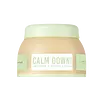What's inside
What's inside
 Key Ingredients
Key Ingredients

 Benefits
Benefits

 Concerns
Concerns

No concerns
 Ingredients Side-by-side
Ingredients Side-by-side

Water
Skin ConditioningGlycerin
HumectantDicaprylyl Ether
EmollientButylene Glycol
HumectantHydrogenated Ethylhexyl Olivate
EmollientPentylene Glycol
Skin Conditioning1,2-Hexanediol
Skin ConditioningPanthenol
Skin ConditioningHydrogenated Polydecene
EmollientSaccharide Isomerate
HumectantHydroxyethyl Acrylate/Sodium Acryloyldimethyl Taurate Copolymer
Emulsion StabilisingAcrylates/C10-30 Alkyl Acrylate Crosspolymer
Emulsion StabilisingPolymethylsilsesquioxane
Hydrogenated Olive Oil Unsaponifiables
EmollientBoron Nitride
AbsorbentMadecassoside
AntioxidantAloe Barbadensis Leaf Extract
EmollientAllantoin
Skin ConditioningArtemisia Vulgaris Extract
Skin ConditioningAstrocaryum Murumuru Seed Butter
EmollientGlyceryl Acrylate/Acrylic Acid Copolymer
HumectantTromethamine
BufferingEthylhexylglycerin
Skin ConditioningXanthan Gum
EmulsifyingDipotassium Glycyrrhizate
HumectantSodium Phytate
Ceramide NP
Skin ConditioningSodium Citrate
BufferingCitric Acid
BufferingSea Water
HumectantPropanediol
SolventTocopherol
AntioxidantEmiliania Huxleyi Extract
Skin ConditioningWater, Glycerin, Dicaprylyl Ether, Butylene Glycol, Hydrogenated Ethylhexyl Olivate, Pentylene Glycol, 1,2-Hexanediol, Panthenol, Hydrogenated Polydecene, Saccharide Isomerate, Hydroxyethyl Acrylate/Sodium Acryloyldimethyl Taurate Copolymer, Acrylates/C10-30 Alkyl Acrylate Crosspolymer, Polymethylsilsesquioxane, Hydrogenated Olive Oil Unsaponifiables, Boron Nitride, Madecassoside, Aloe Barbadensis Leaf Extract, Allantoin, Artemisia Vulgaris Extract, Astrocaryum Murumuru Seed Butter, Glyceryl Acrylate/Acrylic Acid Copolymer, Tromethamine, Ethylhexylglycerin, Xanthan Gum, Dipotassium Glycyrrhizate, Sodium Phytate, Ceramide NP, Sodium Citrate, Citric Acid, Sea Water, Propanediol, Tocopherol, Emiliania Huxleyi Extract
Algae Extract
EmollientParaffinum Liquidum
EmollientPetrolatum
EmollientGlycerin
HumectantIsohexadecane
EmollientMicrocrystalline Wax
Emulsion StabilisingLanolin Alcohol
EmollientCitrus Aurantifolia Peel Extract
CleansingSesamum Indicum Seed Oil
EmollientEucalyptus Globulus Leaf Oil
PerfumingSesamum Indicum Seed Powder
Skin ConditioningMedicago Sativa Seed Powder
Skin ConditioningHelianthus Annuus Seedcake
AbrasivePrunus Amygdalus Dulcis Seed Meal
AbrasiveSodium Gluconate
Skin ConditioningCopper Gluconate
Skin ConditioningCalcium Gluconate
HumectantMagnesium Gluconate
Skin ConditioningZinc Gluconate
Skin ConditioningMagnesium Sulfate
Paraffin
PerfumingTocopheryl Succinate
AntioxidantNiacin
SmoothingWater
Skin ConditioningBeta-Carotene
Skin ConditioningDecyl Oleate
EmollientAluminum Distearate
Emulsion StabilisingOctyldodecanol
EmollientCitric Acid
BufferingCyanocobalamin
Skin ConditioningMagnesium Stearate
Cosmetic ColorantPanthenol
Skin ConditioningZea Mays Oil
EmulsifyingLimonene
PerfumingGeraniol
PerfumingLinalool
PerfumingHydroxycitronellal
PerfumingCitronellol
PerfumingBenzyl Salicylate
PerfumingBenzyl Benzoate
AntimicrobialSodium Benzoate
MaskingAlcohol Denat.
AntimicrobialParfum
MaskingAlgae Extract, Paraffinum Liquidum, Petrolatum, Glycerin, Isohexadecane, Microcrystalline Wax, Lanolin Alcohol, Citrus Aurantifolia Peel Extract, Sesamum Indicum Seed Oil, Eucalyptus Globulus Leaf Oil, Sesamum Indicum Seed Powder, Medicago Sativa Seed Powder, Helianthus Annuus Seedcake, Prunus Amygdalus Dulcis Seed Meal, Sodium Gluconate, Copper Gluconate, Calcium Gluconate, Magnesium Gluconate, Zinc Gluconate, Magnesium Sulfate, Paraffin, Tocopheryl Succinate, Niacin, Water, Beta-Carotene, Decyl Oleate, Aluminum Distearate, Octyldodecanol, Citric Acid, Cyanocobalamin, Magnesium Stearate, Panthenol, Zea Mays Oil, Limonene, Geraniol, Linalool, Hydroxycitronellal, Citronellol, Benzyl Salicylate, Benzyl Benzoate, Sodium Benzoate, Alcohol Denat., Parfum
 Reviews
Reviews

Ingredients Explained
These ingredients are found in both products.
Ingredients higher up in an ingredient list are typically present in a larger amount.
Citric Acid is an alpha hydroxy acid (AHA) naturally found in citrus fruits like oranges, lemons, and limes.
Like other AHAs, citric acid can exfoliate skin by breaking down the bonds that hold dead skin cells together. This helps reveal smoother and brighter skin underneath.
However, this exfoliating effect only happens at high concentrations (20%) which can be hard to find in cosmetic products.
Due to this, citric acid is usually included in small amounts as a pH adjuster. This helps keep products slightly more acidic and compatible with skin's natural pH.
In skincare formulas, citric acid can:
While it can provide some skin benefits, research shows lactic acid and glycolic acid are generally more effective and less irritating exfoliants.
Most citric acid used in skincare today is made by fermenting sugars (usually from molasses). This synthetic version is identical to the natural citrus form but easier to stabilize and use in formulations.
Read more about some other popular AHA's here:
Learn more about Citric AcidGlycerin is already naturally found in your skin. It helps moisturize and protect your skin.
A study from 2016 found glycerin to be more effective as a humectant than AHAs and hyaluronic acid.
As a humectant, it helps the skin stay hydrated by pulling moisture to your skin. The low molecular weight of glycerin allows it to pull moisture into the deeper layers of your skin.
Hydrated skin improves your skin barrier; Your skin barrier helps protect against irritants and bacteria.
Glycerin has also been found to have antimicrobial and antiviral properties. Due to these properties, glycerin is often used in wound and burn treatments.
In cosmetics, glycerin is usually derived from plants such as soybean or palm. However, it can also be sourced from animals, such as tallow or animal fat.
This ingredient is organic, colorless, odorless, and non-toxic.
Glycerin is the name for this ingredient in American English. British English uses Glycerol/Glycerine.
Learn more about GlycerinPanthenol is a common ingredient that helps hydrate and soothe the skin. It is found naturally in our skin and hair.
There are two forms of panthenol: D and L.
D-panthenol is also known as dexpanthenol. Most cosmetics use dexpanthenol or a mixture of D and L-panthenol.
Panthenol is famous due to its ability to go deeper into the skin's layers. Using this ingredient has numerous pros (and no cons):
Like hyaluronic acid, panthenol is a humectant. Humectants are able to bind and hold large amounts of water to keep skin hydrated.
This ingredient works well for wound healing. It works by increasing tissue in the wound and helps close open wounds.
Once oxidized, panthenol converts to pantothenic acid. Panthothenic acid is found in all living cells.
This ingredient is also referred to as pro-vitamin B5.
Learn more about PanthenolWater. It's the most common cosmetic ingredient of all. You'll usually see it at the top of ingredient lists, meaning that it makes up the largest part of the product.
So why is it so popular? Water most often acts as a solvent - this means that it helps dissolve other ingredients into the formulation.
You'll also recognize water as that liquid we all need to stay alive. If you see this, drink a glass of water. Stay hydrated!
Learn more about Water